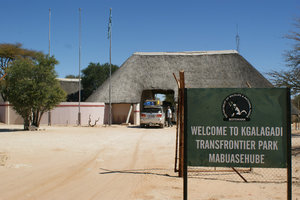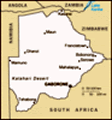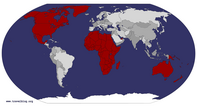Advertisement
Published: August 29th 2013

 DSC05071
DSC05071
Finally arriving at the entrance gateOur lives are touched by many highlights and one of them has to be exploring a new wilderness area.Having cleared all of the immigration formalities at the McCarthy’s Rest border post,which must rank as the World’s least busiest,we headed further west through a bit of parched rural Botswana to Tshabong.Not much there apart from a typically dusty little town in the middle of nowhere leaving one wondering what prompted it’s being there in the first place.Importantly this is where a sign pointing left got the pulse moving a little quicker.Kgalagadi Frontier Park has come about as a result of the amalgamation of large chunks of the Kalahari on both the South African and Botswanan borders and incredibly now spans almost 900,000 sq km’s.That’s big!
The road leading to the entry gate became increasingly sandy and necessitated a stop to reduce tyre pressure to 1.5 psi.Most South Africans who visit the Kgalagadi enter at Twee Rivieren and then spend all of their time in the South African section run by SANParks.More about that later.Our decision to explore the Botswana corner first was driven by it’s remoteness and relatively wilder terrain.Botswana Wildlife has taken a deliberate decision to keep things simpler and

 DSC05076
DSC05076
Typical camp set up.Nicknamed the "Taj"wilder and also to reduce the human footprint by having fewer camp sites,lodges etc., and charging more.So when one arrives at a typical campsite in their parks they are just that.Basic and remote.
Our first stop about 20km’s into the park was the Mabuasehube Pan where there were only four camp sites spread over an area of about 3-4 km’s.No chance of feeling overcrowded.Hopefully the photos tell the story.Camp is set up under acacia trees looking over an ancient dry pan which normally have a man- made water hole.Sadly this one was dry which meant water for showering and cleaning had to be obtained from a neighbouring water hole.Each camp site has a basic ablution block(long drop)and cold shower(where there is water).Camping means being nimble and ever ready to “make a plan” so one then rigs up a portable shower filled by bucket.It works and at the end of a hot day is fantastic.The ablutions are located often 100-200m from the camp site so any thought of a midnight stroll to commune with nature is simply not on.This was proven dramatically on our very first night when we had a couple of lions roaring for some time within 50m

 DSC05101
DSC05101
Looking out over a dry panof where our heads lay.Now there are a few things which ignite fear in humans and right up there is the guttural,booming roar and grunting of a fully grown male lion.It sends shivers down the spine and the brain kicks in with all sorts of crazy thoughts such as “am I on the menu of this hungry lion”?But it is exhilarating and well worth the experience.
We spent three nights at this first camp and the daily routine is simple.Get up in the early morning chill(first morning was minus 5 deg C),get the water boiling and get a hot caffeine fix as quickly as possible.An early morning drive on well marked,surprisingly good sandy roads provides great game viewing opportunities.The most spectacular animal one sees is undoubtedly the Gemsbok which has quite remarkeable markings on it’s legs and flanks.It also has an impressive set of long,straight horns which provide it with a more than useful defence mechanism against lion attacks.Plenty of Springbok which also have beautiful markings.Mid-day sees temperatures nudging up to about 30deg C and a good time to set about camp chores which typically include washing and making ice for sunset drinks.These are onerous tasks and usually then

 DSC05141
DSC05141
Wind and dust equals great sunsetresult in a scramble for the rooftop tent and an afternoon siesta.Sue and Megan are hell bent on breaking all records as they set about playing cards(spite and malice)or rummycub at every available opportunity.A late afternoon drive to a water hole and the all important sundowners brings a serenity to yet another tough day in Africa.Back at camp a fire is lit and dinner at a set table with candles puts a special gloss on being in the bush.No late night revelry and generally tucked into a warm sleeping bag by no later than 8:30pm.Then it’s just the deafening silence punctuated by screeching black backed jackals that hasten sleep.Until the lion roars that is!
After three blissful days we then set off for the next three night stop at Mpaathutlwa Pan.Breaking down and erecting camp is quite a process but with time on our hands it was never a rushed business and like most things in life,it becomes simpler and quicker each time.The daily pattern is much the same at the new camp site although the chilly mornings and evenings were now being replaced by strong,warm winds.This makes camping challenging as the lack of trees and grass results in
sand and dust blowing everywhere.Once again it is a case of making a plan and maneuvering to get out of the wind.We are all keen birders and our tally by the time we left the Kgalagadi was 62 sightings with the most impressive being the large number of Kori Bustards and at the other end of the scale the smaller but beautifully marked Violet Eared Waxbill.Lots of Cape Vultures and the more rare Lappet Faced Vulture seen at the water holes.
A short note about evening dinners.Many people associate camping in the bush with eating a meal out of a can or boiling up instant noodles.This is not the way we do it.The girls had long ago figured out a menu and then set about freezing an impressive array of culinary delights.For example; lamb potjie,butter chicken,thai flavoured chicken,beef stew.Throw in the odd good old braai and it becomes clear that a meal in the bush trumps a meal back home when one factors in ambience,a roaring fire and a night sky which almost seems within arms reach.
Each day’s drive through different sections of the park threw up pleasant and unexpected surprises.Numerous sightings of Black Headed and Red Creasted Korhaans with one obliging us with it’s bizarre aerial display which sees the bird fly straight up and then doing a slow tumbling dive on the way down with feathers fluffed out.An impressive display for any possible suitors who just happened to notice.A number of sightings of the diminutive Steenbok which has been blessed with unusually large ears to detect predators.The Botswana section is not teeming with wild animals as it does not have the dry river beds found in the South African sector.Nevertheless it is stunning and an area of extremes when considering the parched,dry veld and the temperature range with mid-summer peaking at 45deg C.It doesn’t rain much with an annual average of 150-200mm.Because of the lack of water there are no elephant,buffalo or zebra.The lions obliged on one of our nights with their awesome roaring and grunting on the perimeter of the camp site.
Time flies when one is having fun and after six days in this truly wild and untamed environment it was time to break camp and thread our way across to Nossob in the South African sector.This was to be a journey of about 200km’s and wisely we had planned a one night stop at Matopi which is in the middle of nowhere with no ablutions,water or demarcated camp site.Literally a sign indicates one has arrived at Matopi and then a suitable spot is selected under an acacia tree and camp is established.Once again we were pleasantly surprised at how good the sandy roads were and to put things in context we did not need to engage 4x4 once during the entire time spent in Kgalagadi.Thankfully no punctures either.
Nossob lies in the center of the SA Kgalagadi and is akin to some of the camps in Kruger in the sense that there are many camp sites,excellent ablution facilities and generally a lot more “civilized”.This was a one night stop to splurge on proper hot showers and also to do a bit of stocking up in the shop which had most of the basics.Excellent roads and lots of vehicles suggested that game viewing may deteriorate but importantly Nossob camp is situated on the edge of the dry Nossob river bed which attracts huge numbers of animals to feed on what’s left of the short grass found there at this time of year.And this is where,3km’s from camp,we watched a huge male lion feeding on a Wildebeest it had brought down.Not far off were two female lions also feeding on an animal they had caught.Another surprise presented itself on the Nossob road when we were able to watch a leopard resting in a road side tree.Two important ticks for game sighting.
A single night of “civilization” was enough and it was time to move to Rooiputs for three nights which is situated just off the Nossob river bed in the Botswana sector.The wind got very angry on one of the days there and was probably typical of a genuine desert wind storm.Not pleasant but the winds seemed to abate at about 4pm and with all the dust particles in the air the sunsets had spectacular fiery red hues.At this camp we had our closest encounter with a lion which walked right across the site and lay no more than 20m from the A frame shelter where we had earlier had a candle lit dinner.He was a grumpy bastard who may well have been rejected by some female lion judging by his frenetic roaring and grunting which went on for most of the early hours of one morning.
Not everything is big in the bush and we had been commenting about the lack of scorpions until Sue almost stood on one which had it’s nasty little venomous tail in strike mode.One also at night hears the barking gecko which is unique to the region.Each of our campsites proved to be very interesting for curious ground squirrels and yellow mongoose which are quite tame and have learnt that by sticking around long enough there is every chance of being thrown a tit bit.One of the really unusual sightings in this area was a Black Breasted Snake Eagle which had swooped down in front of Bruce’s vehicle to catch a 3ft puff adder which it then promptly dropped on the road.The picture tells the story.A really nasty looking snake writhing alongside us and a very agitated eagle circling overhead ready to reclaim his meal.
Rooiputs was about 20km from Twee Rivieren which we had to visit to clear Botswana immigration.Bigger than Nossob we decided that it was simply too busy and scuttled back to the untamed side.An interesting observation was the significant number of older South Africans traipsing around Kgalagadi,many of whom we kept bumping into at different camp sites.This is a classic case of the “grey nomads” leaving the comforts of city life for the thrills of the bush.We heard of one elderly couple from Cape Town who have so far managed 33 trips to the Kgalagadi.Wow!
The sands of time were now running low and after packing up at Rooiputs we headed in a north westerly direction covering about 150km’s before arriving at Mata Mata which is situated on the Aub river bed.This was to be a one night stop before crossing into Namibia.
In the two drives we did along the Aub river it was evident that large herds of Wildebeest,Springbok and Gemsbok gather to feed on the little vegetation there is.This is reputedly a great spot for cheetah sightings but we were destined not to tick that box.A quick word on the landscape.This is essentially a semi desert region with iron oxide laden red sand dunes dotted along the fringes of the Aub river bed.Keep in mind that this river may flow once every 3-4 years and one gets an idea of just how barren it is.But the colour contrasts mask the starkness magnificently as the white grass clumps flick in the breeze and the river bed proudly supports a small number of ancient acacia thorn trees.Up above the flanks of the river bed it becomes even more desolate with only hardy grass clumps and low scattered bushes clinging desperately to the desert sand.What is truly remarkable is the amount of animals,birds and insects which have all adapted and found a way to survive in these extreme conditions.This includes large numbers of giraffe which were reintroduced a few years back and which one sees often in this sector of the park.
The thing that makes Kgalagadi so special is that it is one of the truly wild,untamed and unspoilt wilderness areas in the World and we felt privileged to have spent time there sharing and enjoying some of it’s uniqueness.
Sitting around yet another camp fire on our last night in Kgalagadi listening to the unmistakable calls of a Pearl Spotted Owl,we suddenly started talking about a trip in September 2014 which would need to include exploring the northern Botswana region of the park.That’s what Kgalagadi does to you.It gets to you and won’t let go easily.
Thoughts turned to the next part of this sojourn.Namibia.
Advertisement
Tot: 0.253s; Tpl: 0.012s; cc: 8; qc: 54; dbt: 0.1092s; 1; m:domysql w:travelblog (10.17.0.13); sld: 1;
; mem: 1.2mb












Barrie Irons
non-member comment
Great Blog
Hi Tim and Sue great to get your news, not sure I could cope with the lions at night, any history of man eaters catching a visitor? Not long before we arrive - really looking forward to it.